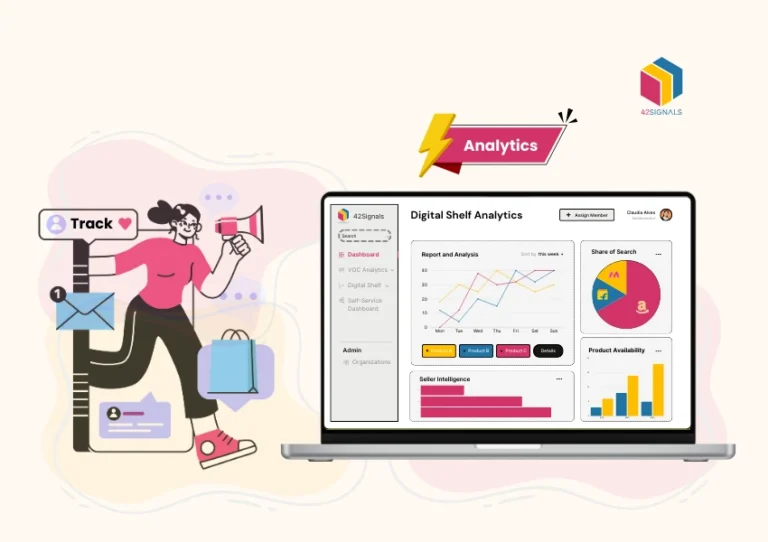Table of Contents
ToggleIn the fast-paced world of e-commerce, staying ahead of the competition is vital for success. With countless businesses vying for customers’ attention, it becomes crucial to gain insights into your competitors’ strategies, strengths, and weaknesses. This is where competitive analysis comes into play. By harnessing the power of e-commerce analytics, you can unlock valuable data that will inform your competitive analysis and enable you to make informed decisions to gain a competitive edge.
In this comprehensive guide, we will walk you through the process of conducting an effective competitive analysis. We’ll explore various aspects of analysis, including defining your competitors and objectives, gathering relevant data, and analyzing your competitors’ websites, social media presence, SEO and advertising strategies, pricing, and promotions.
Let’s dive in and explore the world of competitive analysis in e-commerce and how e-commerce analytics can be your powerful ally in this journey.
Importance of Competitive Analysis in Ecommerce

Competitive analysis allows you to gather valuable insights into the strategies, strengths, and weaknesses of your competitors. By analyzing and benchmarking your business against others in your industry, you can identify opportunities for improvement, develop effective marketing and differentiation strategies, and make informed decisions to stay ahead of the competition.
Here are some key reasons why competitive analysis is essential in the realm of e-commerce:
1. Identifying Industry Trends and Best Practices
Analyzing your competitors provides valuable insights into the latest industry trends and best practices. By studying their strategies and tactics, you can identify emerging trends, new technologies, and innovative approaches to stay relevant and maintain a competitive edge.
- The “Amazon Effect”: Analyze how major players are setting new standards for user experience (UX). For instance, if multiple top competitors implement one-click checkout, augmented reality (AR) product previews, or sophisticated “frequently bought together” algorithms, it signals a trend in reducing friction and enhancing customer confidence. This isn’t about copying; it’s about understanding the evolving baseline of customer expectations. If your checkout process is six steps long and the industry standard is now two, you have a critical gap to address.
- Content and Community Building: Observe how successful competitors are building communities, not just customer lists. Do they have active user-generated content (UGC) campaigns, robust loyalty programs that offer experiential rewards, or insightful blogs that establish thought leadership? These strategies indicate a shift from transactional relationships to emotional connections, a powerful trend in modern e-commerce.
2. Understanding Customer Expectations
Competitive analysis helps you understand customer expectations and preferences within your industry. By examining your competitors’ offerings, customer reviews, and feedback, you can gain a deeper understanding of what customers value, what pain points they experience, and how you can tailor your products, services, and user experience to meet their needs more effectively.
- Pain Point Discovery: By analyzing negative reviews for your competitors, you can identify common customer frustrations—be it about product durability, sizing issues, slow shipping, or poor customer service response times. These are not their problems; they are your opportunities. You can proactively design your product, messaging, and service protocols to directly solve these documented pain points, positioning your brand as the superior solution.
- Desire and Aspiration Identification: Positive reviews reveal what customers truly love. What features do they rave about? What emotional benefits do they highlight (e.g., “this dress made me feel so confident,” “this tool saved me hours of work”)? This intelligence allows you to emphasize similar or superior benefits in your own marketing, speaking directly to the proven desires of the market.
3. Assessing Competitive Positioning
Analyzing your competitors allows you to assess your own positioning within the market. By comparing factors such as pricing, product features, quality, customer service, and brand reputation, you can determine how you stack up against your competitors. This assessment helps you identify areas where you excel and areas where you need to improve to gain a competitive advantage.
- Finding Your Gap: This analysis might reveal that the market is saturated with premium-priced, high-quality brands and low-cost, low-quality alternatives, but there’s a vacant space in the mid-market for a brand offering great quality at a reasonable price. This “gap” is your strategic positioning opportunity.
- Messaging Differentiation: If all your competitors tout “high-quality materials,” your message gets lost. But if your analysis reveals no one is emphasizing “ethically sourced, sustainable production,” that becomes a powerful, ownable differentiator for your brand. Competitive analysis provides the evidence you need to craft a unique and compelling message.
4. Spotting Opportunities and Threats During Competitive Analysis
Competitive analysis helps you identify both opportunities and potential threats within your industry. By monitoring your competitors’ activities, such as new product launches, marketing campaigns, partnerships, or expansion plans, you can proactively respond to market changes and capitalize on untapped opportunities or mitigate potential risks.
- Opportunity Spotting: A competitor discontinuing a popular product line, receiving backlash for a policy change, or failing to stock a key item creates an immediate opportunity for you to capture their dissatisfied customers. Monitoring their inventory levels (if possible) can reveal products they frequently stock out of, indicating high demand you could also fulfill.
- Threat Mitigation: A competitor securing a patent for a key technology, forming an exclusive partnership with a major influencer, or expanding into a new geographic market you serve are potential threats. Early awareness allows you to develop a counter-strategy, whether it’s innovating around the patent, strengthening your own influencer relationships, or doubling down on your marketing in that geographic region to solidify your presence.
5. Enhancing Product and Service Offerings
Studying your competitors’ offerings allows you to gain insights into their product or service features, pricing strategies, and customer satisfaction levels. This information enables you to refine and enhance your own product or service offerings, differentiating yourself by addressing any gaps or shortcomings identified in the market.
- Feature Benchmarking: Create a detailed spreadsheet comparing your product’s features, specifications, and included accessories against those of your top three competitors. This visual aid makes gaps and advantages immediately apparent. Should you include a charging cable if no one else does? Should you develop a mobile app if your main rival’s app has terrible reviews?
- Pricing Strategy Validation: Are you priced too high to be competitive or too low to be perceived as premium? Understanding the pricing tiers within your market, along with the value proposition at each tier, allows you to position your price confidently. It also helps you plan for strategic discounts and promotions that are competitive without triggering a profit-eroding price war.
6. Optimizing Marketing and Advertising Strategies

Competitive analysis helps you optimize your marketing and advertising strategies by understanding how your competitors engage with their target audience. By examining their content marketing efforts, social media presence, SEO strategies, and advertising campaigns, you can gain inspiration, identify effective channels, and differentiate your messaging to better resonate with your target customers.
- Keyword Conquesting: Using tools like SEMrush or SpyFu, you can discover the exact keywords for which your competitors are buying ads and ranking organically. This reveals their core customer acquisition strategy. You can then bid on these same keywords (conquesting) or discover cheaper, high-intent long-tail keywords they are ignoring.
- Creative and Channel Analysis: By monitoring their social ads (via Facebook’s Ad Library) and email campaigns (by subscribing to their lists), you can reverse-engineer their messaging strategies. What offers are they pushing? What visual creative are they using? Which social platforms (TikTok, Pinterest, Facebook) are they most active on? This intelligence helps you refine your own creative assets and allocate your budget to the most effective channels.
Getting Data for Competitive Analysis
Once you understand the importance of competitive analysis in e-commerce, the next step is to gather relevant data to fuel your analysis. Gathering comprehensive and accurate data will provide you with the foundation for making informed decisions and developing effective strategies. Here are some key steps to consider when gathering data for your competitive analysis:
1. Identify Key Competitors
Start by identifying your direct and indirect competitors. Direct competitors are those who offer similar products or services to the same target audience, while indirect competitors may provide alternative solutions to your customers. Make a list of these competitors to focus your data-gathering efforts.
- Tier 1: Direct Competitors: Companies offering very similar products to the same target audience (e.g., Allbirds vs. Rothy’s for sustainable shoes).
- Tier 2: Indirect Competitors: Companies solving the same customer problem with different products or targeting a slightly different audience (e.g., Allbirds vs. Nike for comfortable everyday shoes, or a local bakery vs. a supermarket bakery).
- Tier 3: Aspirational Competitors (Market Leaders): Large, often best-in-class companies you may not directly compete with yet, but whose strategies are worth studying (e.g., a small DTC brand studying Warby Parker’s customer experience or Patagonia’s brand storytelling).
2. Utilize E-commerce Analytics Tools
Leverage e-commerce analytics tools for competitive analysis to gather valuable data about your competitors. These tools can provide insights into various aspects, customer behavior, and more.
- Traffic & SEO Analysis: SEMrush and Ahrefs are indispensable for uncovering a competitor’s organic and paid traffic, top-performing keywords, backlink profile, and content strategy.
- Product & Pricing Tracking: Jungle Scout (for Amazon) or Prisync provide dynamic data on competitors’ sales volume, pricing history, and stock levels, allowing you to react in real-time.
- Ad Intelligence: Facebook Ad Library and Pinterest Ads Manager allow you to see every active ad a competitor is running, giving you insight into their promotional calendar and creative testing.
- Technology Stack Analysis: BuiltWith or Wappalyzer can reveal what software and technologies a competitor uses on their site—their CRM, email marketing platform, payment gateways, and review apps. This can inform your own technology investments.
3. Monitor Social Media and Online Presence
Keep a close eye on your competitors’ social media channels, including Facebook, Instagram, Twitter, and LinkedIn. Observe their content strategies, engagement with customers, and overall brand messaging. Additionally, monitor online review platforms and forums to gather customer feedback and sentiment about your competitors’ products or services.
- Example: After analyzing “Competitor X”:
- Strength: Strong brand recognition, excellent Instagram engagement.
- Weakness: High shipping costs, limited product variety.
- Opportunity: They have negative reviews about customer service response times.
- Threat: They are launching a new product line that overlaps with our core offering.
This structured analysis makes it clear how to act: Differentiate on customer service (24/7 chat), compete on shipping (offer a free threshold), and highlight your broader product selection.
4. Evaluate Pricing and Promotions
Study your competitors’ pricing strategies, including their regular pricing, discounts, and promotions. Monitor changes in their pricing over time to understand their pricing elasticity and how they respond to market conditions. Identify any promotional activities, such as limited-time offers, coupon codes, or loyalty programs. This will help you gain insights into their pricing and promotional tactics.
Become a customer of your competitors. Go through their entire funnel:
- Awareness: How did you first hear about them? Through a Google ad, an influencer, a blog?
- Consideration: Browse their site. How is the UX? Is navigation intuitive? How do they display products?
- Conversion: Go to checkout. What is the process? What payment options do they offer? Is shipping free? Do they have exit-intent pop-ups?
- Post-Purchase: What does the unboxing experience feel like? How are their follow-up emails? What is their return process like?
Document every step. This exercise will reveal countless micro-opportunities to improve your own customer’s journey.
5. Leverage Publicly Available Data for Competitive Analysis
Explore publicly available data sources, such as industry reports, market research studies, and government publications. These sources can provide valuable information about market trends, industry benchmarks, and customer behavior. Analyze this data in conjunction with your competitors’ data to gain a holistic view of the market landscape.
In Summary of Competitive Analysis

Conducting an effective competitive analysis is an essential step for e-commerce businesses looking to thrive in a highly competitive marketplace. By leveraging the power of e-commerce analytics tools, you can gather valuable data and insights that inform your decision-making and drive strategic planning.
A thorough competitive analysis allows you to understand industry trends, customer expectations, and your own competitive positioning. It helps you identify opportunities for improvement, refine your product offerings, optimize marketing strategies, and make informed decisions to gain a competitive edge. By monitoring your competitors’ pricing, product assortment, user experience, SEO strategies, social media presence, and customer sentiment, you can benchmark your own business and uncover areas for growth and differentiation.
Remember, competitive analysis is an ongoing process that requires continuous monitoring and adaptation. The e-commerce landscape is dynamic, and competitors’ strategies evolve over time. Regularly updating your analysis and staying up-to-date with market trends and customer preferences is vital to maintaining your competitive advantage.
By embracing a data-driven approach and utilizing e-commerce analytics tools effectively, you can position your business for sustained success. Competitive analysis provides you with the insights necessary to refine your strategies, optimize your operations, and deliver exceptional customer experiences.
Frequently Asked Questions
What is in a competitive analysis?
A competitive analysis includes a deep dive into your industry landscape to understand how your brand or product stacks up against direct and indirect competitors. It typically covers:
- Market positioning – how each brand is perceived.
- Product or service comparison – key features, pricing, quality, and innovation.
- Marketing strategies – advertising channels, messaging, SEO, social media presence.
- Customer sentiment – reviews, ratings, complaints, and loyalty levels.
- SWOT analysis – identifying strengths, weaknesses, opportunities, and threats.
- Sales and growth trends – including revenue estimates, customer base size, or expansion tactics.
The goal is to uncover gaps in the market, avoid threats, and find new areas to outperform others.
What are the 6 steps of competitive analysis?
A structured competitive analysis often follows these six key steps:
- Identify your competitors – List your direct, indirect, substitute, and potential competitors.
- Gather competitor data – Collect information on their offerings, pricing, customers, and marketing.
- Analyze their strengths and weaknesses – Use tools like SWOT or feature comparison matrices.
- Compare their market strategies – Look at messaging, distribution, and branding.
- Evaluate market position and trends – Identify who leads the market and who’s gaining traction.
- Draw actionable insights – Use findings to refine your own product, pricing, and positioning.
What are the 5 steps of a competitive analysis?
A simpler model of competitive analysis can be boiled down to five core steps:
- Define your objectives – What do you want to learn (e.g., pricing, messaging, positioning)?
- Select competitors to study – Focus on relevant and comparable players.
- Collect relevant data – From websites, reviews, social media, news, and public reports.
- Analyze and benchmark – Use visual tools like charts or competitor scorecards.
- Adapt your strategy – Make decisions based on gaps, opportunities, or threats identified.
What are the 4 P’s of competitive analysis?
The 4 P’s commonly used in competitive analysis are:
- Product – What are your competitors selling? What features, quality, or innovation do they offer?
- Price – How are their products priced, and how does it impact market perception?
- Place – Where and how do they sell? (e.g., retail, online, direct-to-consumer)
- Promotion – What marketing channels and messages are they using to attract customers?
These four pillars help dissect the core go-to-market strategy of each competitor and give insights into how to position your own brand effectively.




